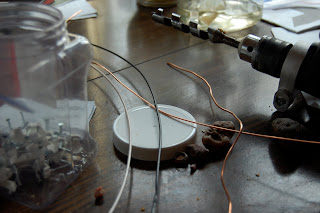It' official: we passed our rough-in electrical inspection! Mainly due to my inexperience, wiring has been by far the most intimidating aspect of this project. I knew absolutely nothing of the trade walking into this project. And now, in lieu of passing my first inspection, I can say that I know the basics.
The beauty of electricity is that it works simply. Energy flows from a big wire to little wires to a outlet or receptacle that a switch controls. The hard part is making sure that your circuit allows the energy to flow without any interruptions (and according to code).
Planning out the design was by far the most difficult part of the job. For one, you actually have to follow a code. For another, the end result has to make sense. There has to be some kind of logic to how you wire the place otherwise you end up with a spaghetti noodle looking mess where the switches don't turn the right lights. But the real motivating factor to come up with a solid circuit design for a frugal Norwegian like me is money. The last thing that I want is to double back copper wire over itself because I didn't think it through! Needless to say that even with the help of friends, neighbors and a good "how to" book it took me over a month to completely design our circuits.
Although it took me a while to figure the design and amass materials, once I actually started wiring things went pretty fast. The first step was to place the receptacle boxes. Next I drilled holes in the studs for the wire to go through and pulled the wire. Now that the wire is pulled through the wall or up and over the trusses from the service panel to the receptacle boxes the actual wiring begins.
I really enjoyed wiring up the boxes and panel. The work requires a great deal of precision but when you are wiring a new construction there is a great deal of leeway in the respect that you can make it up as you go. With a little bit of common sense (knowing what each of the wires is doing) I wired up the boxes.
My attention then turned to the panel. In any home, electricity flows from the main service line into a panel. Once in the panel the energy flows through a circuit breaker and then on through each of the individual circuits. Circuits breakers are a good thing. Each circuit has it's own breaker. Breakers protect that circuit by cutting off the flow of energy if it detects any change in the electrical flow (overload or short). Code specifies what kind of breakers are used based on the amperage of the circuit and what the circuit is energizing.
Once the panel and boxes were wired I made sure that everything looked nice and organized for the inspection. When spring road restrictions are lifted our utility company with pull the main power in from the base of the driveway. We will then connect that power source to the panel, get the final inspection and energize the system.
The learning curve was certainly steep. However with the help of friends (Special thanks to Dan, Joe and Isaac!), a good book, and some common sense the castle is now wired.
I'm now back on familiar grounds: carpentry!
Time to insulate and drywall...




One last bit of advice: label the shit out of that circuit breaker panel. Nothing worse than inadvertently switching off every alarm clock in the house when you need to change out a receptacle.
ReplyDelete